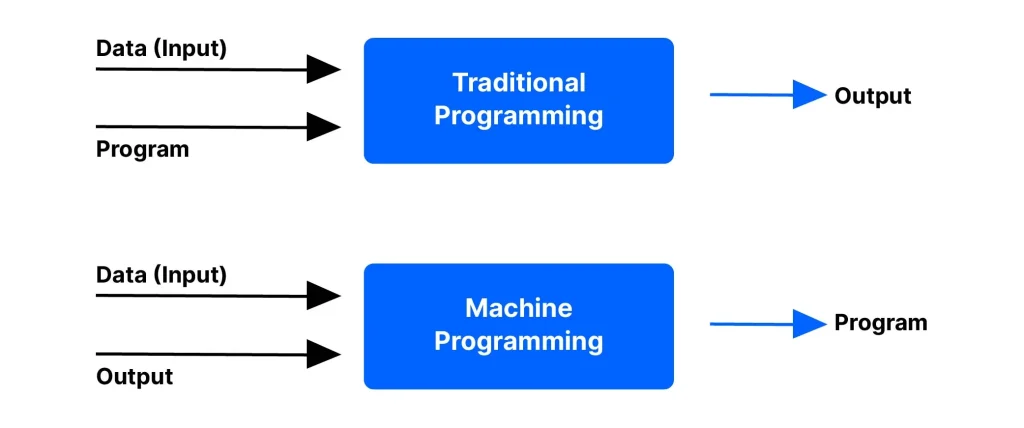Rule-based AI vs Machine Learning: Which One is Best for Your Enterprise
When teams operate independently, it creates communication gaps that can lead to disorder. In contrast, when teams collaborate, they tend to be more efficient.
Introduction
A lot of novel ideas hit the market as artificial intelligence emerged. Al changed several facets of the worldwide industry, whether it was conversational chatbots for customer support or computer vision applications. Likely, other crucial Al elements that are rapidly gaining traction in the digital age include rule-based systems and machine-learning solutions. The comparison of rule-based vs machine learning methodologies reveals the tension between structured, predetermined rules and the dynamic, data-driven adaptability inherent in machine learning models.
As everyone knows, machines are not born with the ability to understand themselves. To make them intelligent and automated, they must be trained. Herein lies the significance of the rule-based versus machine-learning concept! After analyzing the unstructured data, both rule-based systems and machine learning technologies provide insights.
Still, every other business appears to be confused between machine learning and rule-based learning.
So how can you decide which of the two is better? That’s the main focus of our blog, after all! We’ll compare rule-based and machine learning today so you can decide which is best for your business! However, first things first. Fraud Detection Using Machine Learning emerges as a dynamic and adaptive solution, harnessing the power of advanced algorithms to continuously evolve and uncover intricate patterns, setting it apart from the rigid rule-based approaches explored in the comparison with AI in your blog.
What are rule based systems?
A rule-based AI system is one that uses a model that is exclusively based on predefined rules to achieve artificial intelligence (AI). This basic system consists of a set of human-coded rules that produce predetermined results. “If-then” coding statements (i.e., “if X performs Y, then Z is the result”) describe these AI system models. “A set of rules” and “a set of facts” are two crucial components of rule-based AI models, and developers can build a simple artificial intelligence model utilizing them. One way to think about these systems is as an improved version of robotic process automation (RPA).
A rule-based system is a type of artificial intelligence (AI) or computer program that makes decisions or processes information based on a set of predefined rules and logic. These rules are typically established by human experts in a particular domain. The system evaluates input data against these rules to derive conclusions, make decisions, or generate specific outcomes. Rule-based systems are commonly used in expert systems, business applications, and other contexts where decision-making follows well-defined logical patterns.
For example, a bank may utilize a straightforward guideline such as “If the applicant’s age is less <= than 50 and his income is >= $60000 annually,” to determine whether to grant a loan application. This, of course, is a very basic rule; rule-based systems can be incorporated into much more intricate rules to determine the eligibility of the applicant and whether to grant or deny the request. When evaluating problem-solving strategies, the dichotomy of rule based vs machine learning methodologies becomes apparent, emphasizing the trade-off between explicit instructions and the ability to autonomously learn patterns from data.

What is Machine Learning?
A machine learning model is a system that uses machine learning (ML) to develop artificial intelligence (AI). Without human assistance, machine learning systems are intended to establish their own set of rules based on the data that they have access to. ML systems therefore use a probabilistic method, which takes into account variations and probabilities to produce educated results, by just using the outputs from data or experts. This implies that when new information is added, they continuously change, grow, and adapt.
Machine learning is a subset of artificial intelligence (AI) that involves the development of algorithms and statistical models that enable computers to perform tasks without explicit programming. Instead of being explicitly programmed to perform a task, a machine learning system learns from data and experiences, improving its performance over time. In navigating the landscape of intelligent systems, the discussion around rule based vs machine learning frameworks highlights the challenge of balancing the reliability of predefined rules with the potential for self-improvement through continuous learning.
Rule Based System vs Machine Learning
rule-based systems are suitable for well-defined problems with clear rules, while machine learning excels in handling complex, unstructured data and adapting to new patterns without explicit programming. The choice between them depends on the nature of the problem, the availability of expert knowledge, and the desired level of adaptability.
1. Decision-Making Approach
Rule-Based Systems: make decisions based on a predefined set of rules. Human experts articulate these rules, and the system follows them explicitly.
Machine Learning learns from data to make decisions. The algorithm generalizes patterns from the data it was trained on and applies them to new, unseen data.
2. Handling Complexity
Rule-based systems are effective for well-defined problems with clear rules. They may struggle with complex or ambiguous situations.
Machine Learning excels in handling complex and unstructured data, making it suitable for tasks like image recognition, natural language processing, and pattern recognition.
3. Expertise Requirement
Rule-based systems require input from domain experts to define rules, making them suitable for tasks where human expertise is readily available.
Machine Learning requires expertise in selecting and preparing data, choosing appropriate algorithms, and tuning parameters. Often used when the underlying patterns are not easily expressible in rules.
4. Interpretability
Rule-Based Systems are generally more interpretable, as the decision-making process is explicit and follows predefined rules.
Machine Learning can be seen as a “black box” in some cases, especially with complex models like deep neural networks, where understanding the decision-making process may be challenging.
But with a rule-based method with, let’s say, 100 sets of conditional rules, a single little mistake necessitates human work to double-check the entire series. Because of this, rule-based AI systems are frequently chosen for small-scale projects requiring little work, money, or updates. As industries grapple with decision-making frameworks, the rule-based vs machine learning debate reflects the deliberation between structured, rule-driven processes and the dynamic, adaptive capabilities inherent in machine learning algorithms.
Rule-based Vs Machine Learning: Choosing the Right Strategy
Businesses frequently encounter significant obstacles as they match the appropriate AI technique to their primary goal in the lead-up to automation. Without professional advice and assistance, the argument between rule-based AI and machine learning becomes a never-ending one for enterprises.
Qualitative and Quantitative data
Rule-based AI systems require less data than machine learning models, as previously indicated. Companies ought to be well-versed in the kind of data that their system would assume.
Rule-based systems, for instance, may determine whether a city has a Mexican restaurant by using simple data, such as the names of the cities. To generate multiple solutions, ML models may need full demographic information about each city in addition to information about ratings, routes, menus, and other features.
Project Scale
Systems that rely on rules are not naturally scalable. It suggests that the same model that responds to city names containing Mexican eateries might grow too intricate to recommend more eateries. On the other hand, machine learning models are easily saleable through the use of “dialogues” and “intents” to train the model to respond to a wide range of restaurant-related queries.
Mutability
An object whose state can be changed after creation is referred to as a “mutable object” in functional programming. But “immutable objects,” like rule-based artificial intelligence systems, are inflexible systems that are difficult to modify in terms of field and output. Using changeable programming languages like Java, mutable programming in machine learning models allows organizations to modify the values or data.
Final Words
The ongoing discourse on rule based vs machine learning systems underscores the pivotal choice between relying on established guidelines or leveraging the power of algorithms to independently glean insights and optimize performance. Many businesses are now seeking AI chatbot development services to enhance customer engagement and streamline communication processes, leveraging advanced technology to create intelligent and responsive virtual assistants.
Both machine learning (ML) systems and rules-based systems have advantages and disadvantages. However, these can only be ascertained by the specifications of your project. Rules-based systems are ideal for situations when precision within a certain framework parameter is required. ML systems, on the other hand, are your best option if you need to make a prediction and have access to a lot of data. However, a hybrid method can be what you’re looking for if your business demands call for both accuracy and large-scale data processing to support forecasts and projections.
Transform Business Operations and Drive Innovation with IntellicoWorks!
Follow IntellicoWorks for more insights!


